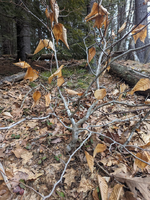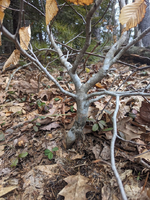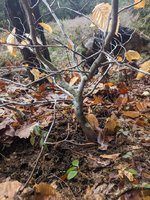JohnnyUtah
Seedling
This tree was chopped by a road maintenance crew a couple of years ago on a fire road where I work. It back budded like crazy over those years. I was thinking about asking if I can dig it up. Worth it?
Yeah that’s the thing I have dug up 3 AB over the last couple of years and so far so good. This is def the largest tree I would be trying to dig up yet. Any thing else I should take in to account with a slightly older tree? It does not appear to be a sucker.I would want that tree, but make sure you know what you're doing when it comes to aftercare. Fagus grandifolia is finicky about its roots, and if it's a sucker from another nearby tree, forget it.
I have 6 American beech and have never had an issue collecting them and that one looks like great material. I have even collected a monster 40 year old beech - trunk chopped, mostly bare rooted( I do it to all of them ) and I haven't lost one yet. Make sure you dig up the soil there, THEN once your home you can remove he native soil and plant it in a training pot. but if you have a method that works, keep doing that.
No, I would not.
It has weird nebari and no taper. You'll spend years trying to correct the former and you more or less can't correct the latter.
I would pass also due to the low split in the trunk that will cause a issues for your nebari and base. I think that area leads to a large root which is evidence of a poor nebari.How can you tell it has weird nebari? It's buried under the soil.
I do see that the tree doesn't have any taper, but I'm not sure I understand why that's a problem. Trees don't normally grow tapered trunks on their own. If you want taper, you're generally going to have to grow it yourself or pay a lot of money for someone else to do it for you.
At the end of the day, it's a free tree with a fat trunk and lots of branches to play around with. I see no drawbacks.
So I was able to collect and I went for it. Like others said it doesn't have great nebari all around but one side looks awesome. Sorry the photos don't show that but here it is after collection. Should I get rid of some branches as to save energy for recovery or just don't touch it at all? The 3 I have collected previously are not nearly this large and I cleaned up the branches right after collection. I'm just not sure how I want to handle that with this older larger tree.I have 6 American beech and have never had an issue collecting them and that one looks like great material. I have even collected a monster 40 year old beech - trunk chopped, mostly bare rooted( I do it to all of them ) and I haven't lost one yet. Make sure you dig up the soil there, THEN once your home you can remove he native soil and plant it in a training pot. but if you have a method that works, keep doing that.
Here it is defoliated.maybe gently remove the leaves so we can see the structure?
I have read a few thread and know you have a good amount of experience collecting American Beech. Would you reduce any of the branching on this one, or stick to a do not touch it rule for at least this spring or even a whole year?How can you tell it has weird nebari? It's buried under the soil.
I do see that the tree doesn't have any taper, but I'm not sure I understand why that's a problem. Trees don't normally grow tapered trunks on their own. If you want taper, you're generally going to have to grow it yourself or pay a lot of money for someone else to do it for you.
At the end of the day, it's a free tree with a fat trunk and lots of branches to play around with. I see no drawbacks.
I have read a few thread and know you have a good amount of experience collecting American Beech. Would you reduce any of the branching on this one, or stick to a do not touch it rule for at least this spring or even a whole year?
This is exactly what I was looking for. Much thanks.I wouldn't say a good amount of experience. I have some experience collecting American beech, which is more than many bonsai practitioners, who prefer to stick with Japanese species, but still not much.
That said, I feel confident in commenting that beech trees should be developed a little bit like conifers, at least for a few years after collection. They prefer to have active buds drawing sap up through their branches, and if they backbud, it tends to come from dormant buds, rather than brand new buds, so you should try to leave active buds in place to give the tree the strength it needs while it gets established. If you don't, then backbudding will be sporadic, and the tree will be weaker than it could have been. Sacrifice branches are a good idea, since you want a certain amount of vigorous growth somewhere on the tree in order to support root development, but you need to be careful about the branches you plan to keep, so the growth doesn't become too coarse.
There is one other consideration you should mind: apical dominance. If you have lots of branches and few roots, the tree will only support a portion of its active buds, and it will choose the buds at the ends of its branches. That will lead to leggy growth and poor ramification. I learned the hard way that it's difficult to chase the growth back from that point. If you don't choose buds, the tree will choose them for you, and it's hard to go back.
That brings us to a point where your treatment of the tree comes down to a judgment call. You want to leave lots of buds to maximize the vigor of the tree during recovery, but if you don't have many roots, the tree may only push the buds at its apex, and it could even abort all of those nice lower branches. It's about striking a balance based on experience. That's also why I emphasized that my experience is limited. My advice doesn't come with a guarantee.
All of that said, I recommend that you shorten every branch on the tree back to two active buds, and then let it go. Let it grow all summer, and let it accumulate as much energy as it can to maximize the chance it survives next winter. If it survives a full year, then in the fall of 2025, do some more branch selection after the tree has gone dormant. From there, you can remove useless branches and keep your important structural branches and sacrifice branches.
Don't worry about your eventual chop height for building taper until you reach that point. American beech trees heal chop wounds faster than anything else I've worked with (including Acer rubrum), so a two-year delay in chopping the trunk won't affect your long-term development plans as much as other species. Focus on growing good branches, and chop back to one of those branches when the time comes.



I came here looking for information on American Beech. I found this little tree on the edge of some power lines and thought it looked very interesting. As a beginner I'm a little intimidated by what everyone is saying in regards to keeping A.B. as a bonsai. Maybe I'll leave it alone and collect it in a few years after I have gained some experience. This tree is not growing anywhere near any other beech trees. There is a large grove further down the power lines, but they are about a half mile away.
I'd love some advice or opinions if anyone has any input. The first two pics are from the "front side" and the third picture is taken from the opposite side.
Thanks in advance for any information or advice. I have thoroughly read through his whole thread very carefully so no need to retype anything that's already been offered. for context, i am located in Southern Maine ( Zone 5B ).
View attachment 531757 View attachment 531758 View attachment 531759
